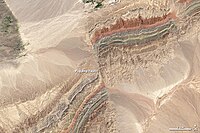
Photo from wikipedia
Abstract The characterization of a seismogenic zone associated with the rupture process that occurs during great megathrust earthquakes has been approached from different perspectives. Different studies lightened the structural complexity… Click to show full abstract
Abstract The characterization of a seismogenic zone associated with the rupture process that occurs during great megathrust earthquakes has been approached from different perspectives. Different studies lightened the structural complexity and compositional heterogeneity of the interplate region. In this work, we address this relationship from the analysis of density contrasts provided by satellite gravity data and comparing these results with slip behavior along the rupture zone. We performed the calculation of gravity anomalies and gradients both corrected by the effect of topography and sediments. Then we analyzed this relation with the rupture zones of four megathrust earthquakes Mw > 8 along the Peru-Chilean coast, associated with the largest earthquakes that occurred in the last years along this setting, finding that the maximum vertical displacements were located close to gravity minimums in the forearc zone. We finally obtained density models by inverting four trench-parallel profiles from the Gravity disturbance, finding low-density contrasts related to the maximum slips, and high density contrasts at its edges related to a decrease of the displacement or to the lateral ending of the rupture. The along-strike seismic segmentation observed previously in the gravity derivatives is also observed along dip, being slip increased at gravity lows and arrested at gravity highs, probably indicating that the forearc structure plays a key role in across strike rupture behavior in depth. Our results agree with the hypothesis that persistent tectonic features, modeled at a high degree by the oceanic plate morphology, may control strain accumulation and release along the megathrust.
Journal Title: Tectonophysics
Year Published: 2019
Link to full text (if available)
Share on Social Media: Sign Up to like & get
recommendations!